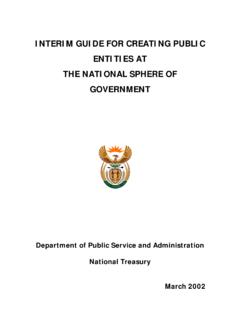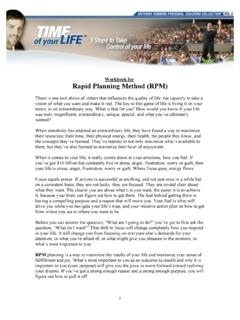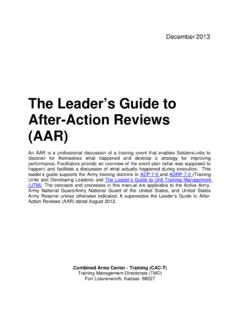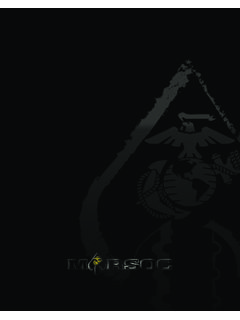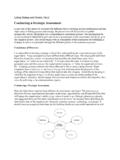Transcription of NGO MANAGER ORGANISATIONAL ASSESSMENT …
1 NGO MANAGERORGANISATIONAL ASSESSMENT tool (OAT)_____Latest version available at: 2004 ORGANISATIONAL ASSESSMENT tool (OAT)2/24 JULY 2004 NGO MANAGERORGANISATIONAL ASSESSMENT tool (OAT)Marco Kirschbaum* and characteristics of the to plan and carry out an ORGANISATIONAL ASSESSMENT ?.. a SWOT analysis: Strengths, Weaknesses, Opportunities and SWOT SWOT Action #1: ORGANISATIONAL ASSESSMENT - Question #2: SWOT Analysis Brainstorming Sheet ..21 Worksheet #3: SWOT Analysis Action Plan Sheet ..22 Worksheet #4: ORGANISATIONAL ASSESSMENT Summary * Very special thanks to Pauline Sawh and Daniel D Esposito for their time, knowledge, experience, patience andsupport. ORGANISATIONAL ASSESSMENT tool (OAT)3/24 JULY and characteristics of the tool The purpose of the ORGANISATIONAL ASSESSMENT tool (OAT) is to helporganisations to improve their performance. It helps to find out their strong andweak points. The OAT is a learning tool on problems and questions concerningthe organisation s strategy, it s management processes, finances, staffing,relationships with others and it s results.
2 It asks to identify causes of problemsand helps in the decision-making to overcome tools are also important for consultants and support organisations,which help NGOs to build their capacity. Ideally, an ORGANISATIONAL assessmentis carried out periodically to measure change and improvement. The tool is simple, task-focused and action-oriented. The statements of thequestionnaire describe the expected capacity of a mature or developedorganisation. The characteristics of the OAT are as follows: Contains a comprehensive list of relevant management issues Promotes process-orientation instead of static listing of positive and negativepoints. The OAT focuses on identifying strengths, weaknesses, opportunitiesand threats with regard to each issue (SWOT analysis) Helps to focus on causes of problems instead of highlighting symptoms only Favours a participatory approach for the ASSESSMENT , dialogue andtransparency on its results. It can be used both by an individual and bygroups. Leads to qualitative statements instead of giving grades Includes a detailed results section, which asks what the organisationsachievements are Provides users with quick overview of level of achievement for eachmanagement issue Results in a clear list of priority subjects for improvement for each issueanalysed Facilitates the setting up of a plan of action Contains easy-to-use worksheets, which can also be used to report on theresults of the ASSESSMENT tool (OAT)4/24 JULY 2004 Many of the existing ASSESSMENT tools are difficult to adapt and modify becausethey are in PDF or HTML format that cannot be modified if downloaded.
3 TheOAT worksheers can be downloaded as Microsoft Word file and thus beadapted to your particular needs (see ).This is important because each organisation faces different managementchallenges and needs to adapt the tool to its particular situation: a newlyestablished organization will need to build up the foundations of the NGO andhave to pay more attention to its governance structure, the board, the leadershipsystem and accounting. An established and somewhat developed organisationmay need to put particular emphasis and work on its human resources andplanning systems. Mature organisations may focus on ASSESSMENT , change andmanagement processes. Therefore each ASSESSMENT MANAGER will need to beable to adapt the ASSESSMENT tool to the organisation's particular needs at thatmoment, selecting certain issues, deleting others and thus creating its own OAT is conceived as an open source instrument. Your are free to use it andto adapt it to your needs. We would very much appreciate if you could send usyour comments and suggestions to improve the tool either directly on thetemplate or in a separate email.
4 Contributions will be acknowledged andmentioned at the NGO MANAGER s website (in case you do not object). to plan and carry out an ORGANISATIONAL ASSESSMENT ? There are three steps for such an ASSESSMENT : step 1: Prepare the ASSESSMENT Define the scope of the ASSESSMENT : choose between carrying out acomprehensive ASSESSMENT , ie. answering all of the questions in theQuestion Menu, or a selective ASSESSMENT , ie. selecting the topics whichare the most important to your organisation at this time. Adapt the Question Menu to suit your specific needs. This tool is easy toedit because all the worksheets are in a commonly used anddownloadable format (Microsoft Word). Decide on who among managers and staff will participate in theassessment. Decide whether an internal ASSESSMENT MANAGER or anexternal facilitator is best suited to lead the ASSESSMENT process. Decide on the form and timing of the enquiry: structured or semi-structured interviews, team-based discussions, ASSESSMENT tool (OAT)5/24 JULY 2004 step 2: Carry out the ASSESSMENT Answer the questions in the Question Menu according to themethodology you have chosen in step one.
5 For each question, determine your level of achievement, the keyrecommendations and their level of priority and record the answers onthe Question now may have a good overall picture of the current capacity of yourorganisation. You also have established recommendations for next step is to set up a plan of action to implement these plan of action should take into account internal as well as external internal strengths and weaknesses, and external opportunities andthreats, or SWOT analysis, is the ASSESSMENT s key tool to create the plan ofaction: step 3: Create a plan of action Do a SWOT a for each of the questions using the SWOT BrainstormingSheet. Brainstorming is most productive in a group. Identify relevant actions to be taken based on the results of the SWOT analysis using the SWOT Action Plan Sheet. Use the Summary Sheet to present your plan of a SWOT analysis: Strengths, Weaknesses, Opportunities and Threat s SWOT analysis is an effective, simple and widely used tool .
6 It can be carried outindividually and in groups. The organisation s internal situation is describedunder the headings of strengths and weaknesses. The external factors arecondensed under the headings of opportunities and threats. To complete acomprehensive overview, the main causes for each factor should be identified,whenever it is useful and SWOT analysis is needed for each sub-topic of the questionnaire. Theanalysis and discussions can be carried out in two steps: SWOT BrainstormingThe purpose of the SWOT brainstorming is to identify and list the key issues atstake and underlying causes. Group sessions are very often most effective forthat purpose. In preparation of SWOT group sessions, it is useful to askORGANISATIONAL ASSESSMENT tool (OAT)6/24 JULY 2004participants to prepare in advance his or her own SWOT analysis. The results ofindividual analysis can then be merged during the group session. SWOT analysis usually stimulates a multitude of different views. These shouldbe recorded in the group s SWOT brainstorming notes and can be weighed, ifneeded.
7 The purpose of this exercise is not to produce consensus on all of theissues, at all cost, but to identify a wide range of factors which generally form thecauses of complex issues. It may even be counterproductive to cut down therichness of differing opinions to a few points, which are commonly 1 InternalStrengthsWeaknesses Available resources Skills you have and which are necessaryto achieve your objectives Capabilities Other advantages, eg. in comparison toother organisations Indicate main causes Lack of resources (financial, human, etc.) Lack of skills Lack of capabilities Disadvantages, eg. in comparison to others Lack of ORGANISATIONAL infrastructure Indicate main causesOpportunitiesThreats / constraints External Chances you may have due to policychange of government, funders and otherstakeholders Trends Events such as workshops where you canexplain your programmes and projects Indicate main causes Obstacles Increased competition from other organisations Continued over-spending / under funding Indicate main causesUsing SWOT analysis is helpful and stimulating if you wish to compare yourorganisation to one or several other organisations that are active in the samefield.
8 While you may not obtain as many details as for your own organization, aSWOT comparison tells you what you do know, highlights what you do not knowand helps to learn from others thereby enhancing the SWOT analysis made ofyour own SWOT Action PlanAfter identifying key strengths, weaknesses, opportunities and threats, theresults should be linked to each other in order to create the detailed plan ofaction for each topic. Use the SWOT Action Plan all the strengths you have identified and their causes and divide theseinto potential opportunities and threatsORGANISATIONAL ASSESSMENT tool (OAT)7/24 JULY all the weaknesses you have identified and their causes and dividethese into potential opportunities and threatsTable 2 Topic: ..StrengthsWeaknessesOpportunitiesCapita lize on these points: Improve these: ThreatsMonitor these points: Eliminate these: weaknesses that threaten your on the opportunities that are your organisation s weaknesses that may contain areas where your organisation is strong but is challenged bypotential the OAT Summary Sheet to present your plan of WorksheetsWorksheet #1: Question MenuWorksheet #2: SWOT - Brainstorming SheetWorksheet #3: SWOT - Action Plan SheetWorksheet #4: ORGANISATIONAL ASSESSMENT Summary SheetORGANISATIONAL ASSESSMENT tool (OAT)8/24 JULY 2004 Worksheet #1: ORGANISATIONAL ASSESSMENT - Question MenuManagementsubjectObjectiveLevel ofachieve-ment*Level ofpriority:Top/medium/lowRecommendations 1.
9 GoverningStructure Mission,VisionStatementsand ValuesThe Mission, Vision Statements and Values are available. They:- Guide the design of the organisation s strategic aims and objectives; - Are communicated with the staff in ways that they are able to share these with themain stakeholders and the general Statues- The organisation s legal framework is reflected in its The statues include admission criteria for membership, rights and duties of BoardThe board participates in defining policies, fund raising campaigns, advocacy andpublic responsibilities and decision making authority of the board are known to thestaff, and expressed to the general public and respective roles and responsibilities of the board directors and seniormanagement are clearly board composition includes members who are recognized for their leadership intheir respective field of Procedures exist and are applied to facilitate and encourage board members tocontribute to the organisation s development.
10 - Board Members actively demonstrate their members are representatives of stakeholders, and are able to present a widerange of interests held by stakeholders. * Level of achievement: A=not yet started; B=some progress; C= considerable progress; D= achievedORGANISATIONAL ASSESSMENT tool (OAT)9/24 JULY 2004 ManagementsubjectObjectiveLevel ofachieve-ment*Level ofpriority:Top/ ProcessOrientation- The organisation continuously strives to improve its processes and has developedappropriate strategies and resource tools to encourage creativity, implement andcommunicate improvements consistently and reward useful proposals. - There is a policy on change management that facilitates and promotesorganizational change. Strategies for change are permanent features of theleadership agenda. - Periodical reviews of management practices are part of ORGANISATIONAL Organisa-tional chartand staffaccess toleadersThe ORGANISATIONAL chart defines individual responsibilities and is accessible tomembers and are easily accessible to their Meetings,teamworkandknowledgemanagementE ach level of the organisation (department, division) identifies it's needs for one ofthe three purposes of meetings: (1) information exchange, (2) debate andbrainstorming of specific themes, (3) decision-makingAn agenda is available and communicated in advance, thus enabling participants toprepare the taken during meetings are communicated (minutes of meeting) andfollowed and participants regularly assess the quality of meetings.
